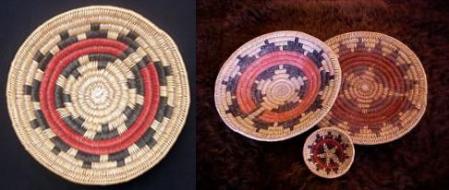I’m always on the lookout for indigenous beliefs that might be distant echoes of Britain’s ancient rock carving tradition. An interesting item cropped up recently on BBC1’s Stephen Fry’s tour of America.
Traditional Navajo ceremonial baskets have a concentric circular design, with every part of the basket having a symbolic relevance to the spiritual life of the Navajo. The gap in the rings creating a line from the centre of the basket is called ‘Shipapu’ and is……..
“…symbolic of the path or means of communication with the world of the ancestor spirits ”
“The Navajo creation story tells how the first people emerged from the center of the earth -symbolized by the center of the basket. The “Shipapu” opening is believed to let the spirits from the underworld out and to allow more births into the upper world.”
“the shipapu is the path of communication between the lower or ancestral worlds of the Navajo and the present world. The shipapu is woven into the basket as a pathway to let the people emerge, and allowing the spirit to come and go.”
“A pathway leads from the center of the basket to the edge. This is “the way out,” or the doorway of the basket, also called the “ceremonial break.”
Food for thought ?

bulletproof dedicated server
Going native? | British Rock Art Blog
The basket is used for many Native Indian cermonies. The ring design on the basket symbol represents your house. The opening or gap is the doorway out from you to everything outward. It allows all the bad to be released from the person. So when you hold it make sure it pointing outward. If you have one make sure you take care of it and have it pointing east. These are things my grandmother taught me. We are from the Navajo tribe and these are of the Navajo ways.
Finally, the Navajo Time Line:
http://kghr.org/culture/navajo-timeline/
I thought it was worth posting this as its the first time i have come across an explanation behind the radial element in this kind of concentric motif. Not saying it applies to british cup and rings, but worth noting all the same, plus the Navajo beliefs are another example of the widespread theme of ‘spirits in the land’ which appears to be be core concept behind so much rock art.
Rich, don’t be too dissappointed, the carvings in the link you posted are right along side a large vertical fissure – OPEN SESAME!
thanks for sorting me out jan. I tried deleting the last post but its not having it.
This is a good (and very artistic!) example of the ‘common’ Navajo rock art:
http://bighugelabs.com/flickr/onblack.php?id=332109951&size=large
Cheers,
Jan
There are not so many Navajo ‘petroglyphs’ which show the C&R with outrunning groove.

Here’s the motif from Richard’s url in context:
Thanks for the url, Rich!
Tip: check the “remove frame” button in the upper right corner of the Google page and you’ll get a ‘normal’ url.
But Tiny Url does the trick also: http://tinyurl.com/5c3ukl
Cheers!
Food….more like a three course meal
Sorry for the long link, but quite a nice Navajo multi-ringed carved effort here:
http://images.google.co.uk/imgres?imgurl=http://www.nm.blm.gov/features/dinetah/disk_images/rock_art_1_600.jpg&imgrefurl=http://www.nm.blm.gov/features/dinetah/navajo_history_2.html&usg=__5IOI7qIYkXbcJty2PiPVGffUU3I=&h=600&w=403&sz=89&hl=en&start=4&um=1&tbnid=ZS2e4rlNBQtGiM:&tbnh=135&tbnw=91&prev=/images%3Fq%3DNavajo%2Brock%2Bart%26um%3D1%26hl%3Den%26sa%3DN
I was hoping to find a couple of outer rings truncated by fissures, but sadly not to be.
That is astonishing – i am always amazed how us humans, whatever our particular beliefs, seem to have an intrinsic knowledge that we are far more than just a bunch of chemicals and stuff. i am amazed too at how different, seemingly unconnected cultures over the ages have conceptualised this awareness in similar ways. As you say – food for thought.
Incidentally, I heard on the radio recently about a small tribe in the Amazon, who feel no need whatsoever to conjure up a deity or spirit world – their attitude being merely that ‘ this is the way things are.’ Apparently they live lives of great bliss and harmony.